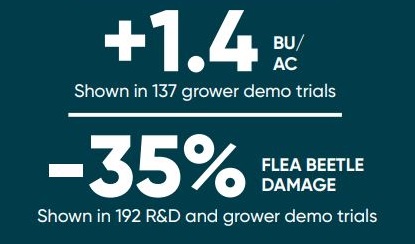Protect your Canola
Get serious about your early season plant health with Lumiderm insecticide seed treatment.
Talk to your retailer or seed treater for more information.


Get the latest news, events and insights from Corteva


group
Lumiderm™ insecticide seed treatment provides excellent plant protection against both flea beetles and cutworms in one convenient bag so you can Win the Start with Canada’s most complete canola seed protection.
Lumiderm™ insecticide seed treatment provides:
1. Exceptional control of flea beetles
2. Proven crucifer protection
3. Industry-leader in plant stand and vigour
4. Excellent early season seedling biomass
Get serious about your early season plant health with Lumiderm insecticide seed treatment.
Talk to your retailer or seed treater for more information.
Lumiderm insecticide seed treatment contains a unique Group 28 insecticide.
Across Western Canada, canola growers are experiencing high flea beetle pressure that is causing significant damage to canola crops, and growers are demanding a better solution. Lumiderm is the solution that provides premium protection against both crucifer and striped flea beetles.
Cutworms are a real problem in canola production and are increasing in pressure. If you’re not paying close attention to your fields, they can destroy a significant portion of your crop in a matter of days. Lumiderm is one of the only seed treatments that protects your canola from cutworm feeding, which helps enhance early season stand establishment and crop vigour.
When you’ve planted Lumiderm treated canola seed your crop will gain an advantage over both cutworms AND flea beetles for up to 35 days of protection. This enhanced protection is critical during the first few weeks of seedling growth, which will allow your canola crop to thrive. Not only does Lumiderm reduce risk from both flea beetle and cutworm damage, it also delivers substantial increases in plant vigour and biomass.
Lumiderm treated canola grows bigger, faster, and more even than untreated canola.

More than 12M acres of canola were treated with Lumiderm in 2022*
*seeding intentions as of May 1, 2022
Lumiderm provides soybean seedlings with extended protection against key early season insects: soybean aphid, bean leaf beetle, seed corn maggot, European chafer, Japanese beetle, white grub, wireworm, and cutworms.
Lumiderm contains a unique Group 28 insecticide, a non-neonic seed treatment option with minimal impact on the environment that reduces administration paperwork. It also has minimal impact on beneficial insects and pollinators when used in accordance with the label1.
Lumiderm insecticide seed treatment provides broad spectrum protection from early season insects in soybeans and completes the soybean protection package with Lumisena™ fungicide seed treatment.
To maximize yield potential, insect and disease protection go hand-in-hand. Lumiderm complements Lumisena fungicide seed treatment and results in healthier, more abundant soybean stands.
Get serious seed protection for your soybeans and maximize your yield potential with Lumisena fungicide seed treatment and Lumiderm insecticide seed treatment.
Read the article nowLumisena™ and Lumiderm™ seed treatments: the perfect pair
Insecticide seed treatment for use on canola and soybeans.
Canola (Brassica spp.)
Soybean
28
Explore our wider lineup of soybean and canola crop protection products.
As with all crop protection products, read and follow label instructions carefully. Member of CropLife Canada.
1In line with Integrated Pest Management and Good Agricultural Practices, insecticide applications should be made when pollinators are not foraging to avoid unnecessary exposure.
